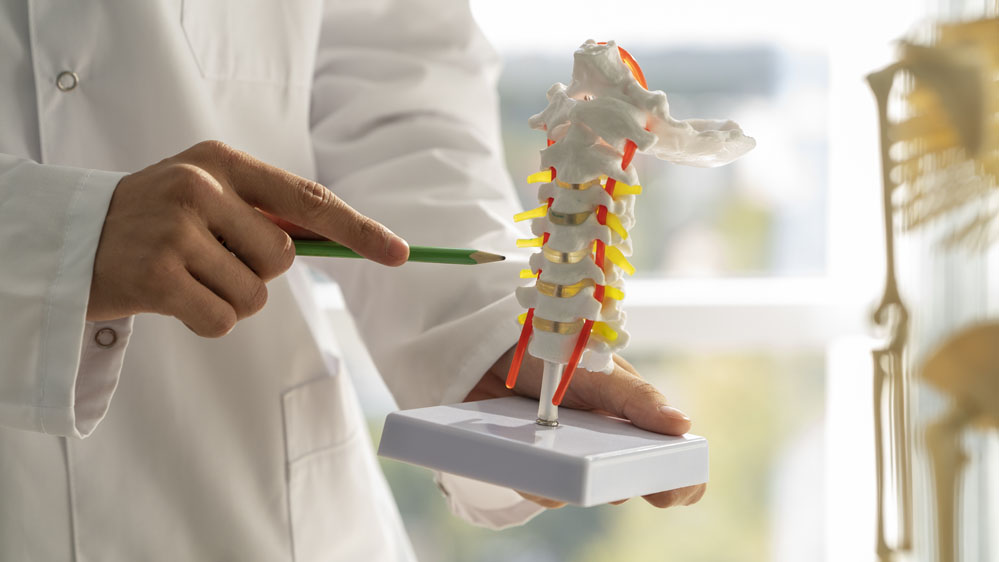Spinal Decompression Surgeries for Back and Nerve Pain
Spinal Decompression Surgeries for Back and Nerve Pain
Tingling, weakness and numbness in your hands and feet may not feel serious enough to prompt a visit to your doctor. But if you’ve had these symptoms for a long time, don’t ignore them, especially if they’re accompanied by neck or back pain.
You may benefit from a spinal decompression procedure performed by the experienced, board-certified orthopedic surgeons with the Beaufort Memorial Advanced Orthopedics and Spine Program. Our surgeons help patients throughout Beaufort, Jasper, Hampton and Colleton counties manage chronic nerve and back pain using the most sophisticated approaches available.
Call 843-522-5485 to discuss your symptoms or request an appointment with a board-certified spine specialist at Beaufort Memorial.

Your Spine’s Anatomy
Your spine, or spinal column, extends the length of your back, starting at the top of your neck and traveling down to your pelvis, ending at your tailbone, or coccyx. The column is made of more than 30 bones in the spine called vertebrae, which are separated by pieces of cartilage called intervertebral discs. Various ligaments and tendons connect to your spine to hold the vertebrae in place.
Your spinal cord travels through your spinal canal thanks to spaces in the middle of each vertebra. Coming off the spinal cord are 31 pairs of nerves called nerve roots that send sensory and motor signals to the rest of your body. Those nerve roots exit the spinal canal through spaces between the vertebrae called the foramen.
Effective Treatments for Spinal Stenosis and More
Many conditions can put pressure on the spinal cord or the nerve roots, leading to symptoms such as pain, numbness, tingling and weakness. Spinal decompression surgeries can help alleviate those symptoms. During these procedures, your surgeon removes bones, ligaments, disc materials and tissue that put pressure on your nerves and spinal cord.
There are two common types of spinal decompression surgery — laminectomy and foraminotomy.
In a laminectomy, your surgeon removes the lamina, which is on the back of the vertebra and forms part of the spinal canal. A laminectomy may also involve removal of bone spurs that exist in or near the spinal canal. The goal is to widen the spinal canal and relieve pressure on the nerves.
In a foraminotomy, your surgeon removes bone or bone spurs near the foramen. This allows more space for nerve roots to travel through, relieving pressure on the nerves and your symptoms. Your surgeon may perform a foraminotomy along with a laminectomy.
Spine surgeons at Beaufort Memorial offer other solutions to conditions that cause spinal compression. A corpectomy involves removing one or more vertebrae as well as nearby discs to allow for complete decompression of the spinal cord and nerve roots. A discectomy can also relieve pressure on nerves and relieve symptoms related to sciatica. During this procedure, your surgeon removes portions of the disc that has moved out of place and is putting pressure on nearby nerves.
Conditions Treated by Spinal Decompression Surgeries
The type of spinal surgery you have depends on your diagnosis. Spinal decompression surgeries can help with a variety of conditions, including:
- Spinal stenosis. Spinal stenosis is a narrowing of the spinal canal that puts pressure on the spinal cord and nerve roots. It can be caused by arthritis, fractures or chronic medical conditions, or it can develop as a result of conditions you’re born with. Spinal stenosis often affects the top of the spine (cervical spine) or lower part of the spine (lumbar spine).
- Myelopathy. Myelopathy refers to symptoms that develop because of spinal compression — stiff or tight muscles, clumsiness in the hands and fingers, and difficulty walking normally. It can be caused by spinal stenosis, as well as herniated discs and spondylolisthesis.
- Radiculopathy. Like myelopathy, radiculopathy — the medical term for a pinched nerve — develops when nerve roots anywhere along the spine are compressed or irritated. It’s marked by symptoms such as numbness, weakness, problems with reflexes, and shooting pain or pain that feels like an electrical shock and radiates from your buttocks to your feet. Many conditions can cause radiculopathy, including spinal stenosis, herniated discs, trauma, infections and some vascular conditions.
Spinal Decompression Recovery and Rehabilitation
Surgical treatment for spinal stenosis and other conditions that cause spinal compression is often successful. Full recovery can take a few months depending on the type of surgery you have, but you may be able to return to work within a few days or weeks.
Spinal decompression surgery usually requires a few days in the hospital and will likely involve general anesthesia. You’ll be asleep throughout the entire procedure. However, your recovery team will encourage you to start walking as soon as possible after your procedure.
Spine surgery can be painful, so your recovery plan will likely involve a short course of prescription medications to help you manage pain. However, you’ll also receive physical therapy to strengthen and rehabilitate your back muscles. Your surgeon or therapist may also recommend wearing a back brace or corset as you recover.
The board-certified spine surgeons at Beaufort Memorial have experience performing many procedures to help you overcome back, neck and nerve pain. To discuss solutions to your pain, request an appointment with one of our surgeons.
